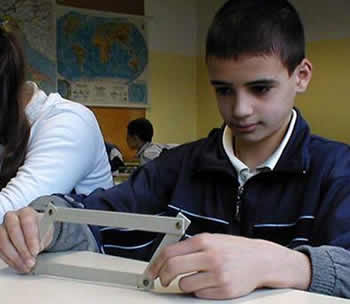
THE QUADRILATERAL PROPERTIES
Making conjectures on the properties of shapes is
often difficult when the students are required to analyse static figures.
It is easier to do this if the students have the possibility to observe a lot
of shapes that gradually change from one into another. In this activity properties
of quadrilaterals (rectangles, parallelograms, squares and rhombus) are examined,
manipulating the dynamic shapes by dragging a vertex.
The path
- Guessing the invariants and variables
- From the observation to the abstraction: What happens at the limit?
- Verify conjectures by measurement.
- Classify the quadrilaterals on the basis of the identified properties.
- Models made with cardboard stripes
- Dynamic geometrical software (CABRI)
The cardboard models
- Square transformable in rhomb (4 equal stripes connected each other at their extremes)
- Rectangle transformable in parallelogram (2 couples of equal stripes connected each other at their extremes))
- Rectangle transformable in square (2 equal stripes connected each other at their middle points as diagonals and an elastic string trough their extremes as sides).
-
Parallelogram transformable in rhomb (2 stripes with different length connected each other at their middle points as diagonals and an elastic spring trough their extremes as sides)
In alternative students can work with CABRI, using given shapes and instructions (see CABRI files).
The activities
The aim is to encourage students to make and check
conjectures and to transform their intuitive notions into more formal
ideas about geometrical properties.
Pupils are invited to find out what common characteristics couple of quadrilaterals
share and how they differ. The couple of quadrilaterals are: parallelograms
and rectangles, squares and rhombus, rectangles and squares, parallelograms
and rhombus.
Elements to be observed:
- sides (relationship between length, sum, parallelism)
- angles (relationship between amplitude, sum)
- diagonals (sum, perpendicularity, point of intersection)
- area
 |
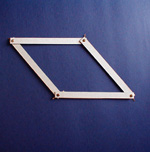 |
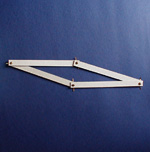 |
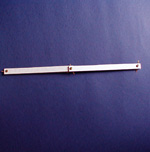 |
Two angles become bigger, the other two smaller, one couple gains what the other one loses, the sum is constant.
Sum of diagonals
One diagonal becomes longer, the other one shorter,
but their sum isn't constant! The extreme case helps to find it out.
Students are invited to take account of two elements:
1. in every square each diagonal is longer
than the side
2. in the extreme case, when the square is
flattened, the two diagonals measure respectively 0 and two
sides. Their sum must be shorter than in the square.
Invariant or variable?
The idea of "compensation" between what
is gained and what is lost is rooted in the pupils.
Reasoning about what will happen to the diagonal sum in the dynamic square
offers the opportunity to show how the immediate perception may lead to wrong
conclusions and then to the necessity of a more precise and formal thought.
This kind of exercise opens "windows" on
mathematical concepts that will be deepened later.
On-screen measurements for side lengths and angles can help students to "see" what
happens when the dynamic square is manipulated.
Bijection between points
A typical mistake is to identify the perimeter
with the figure itself. |
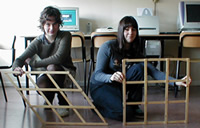 |